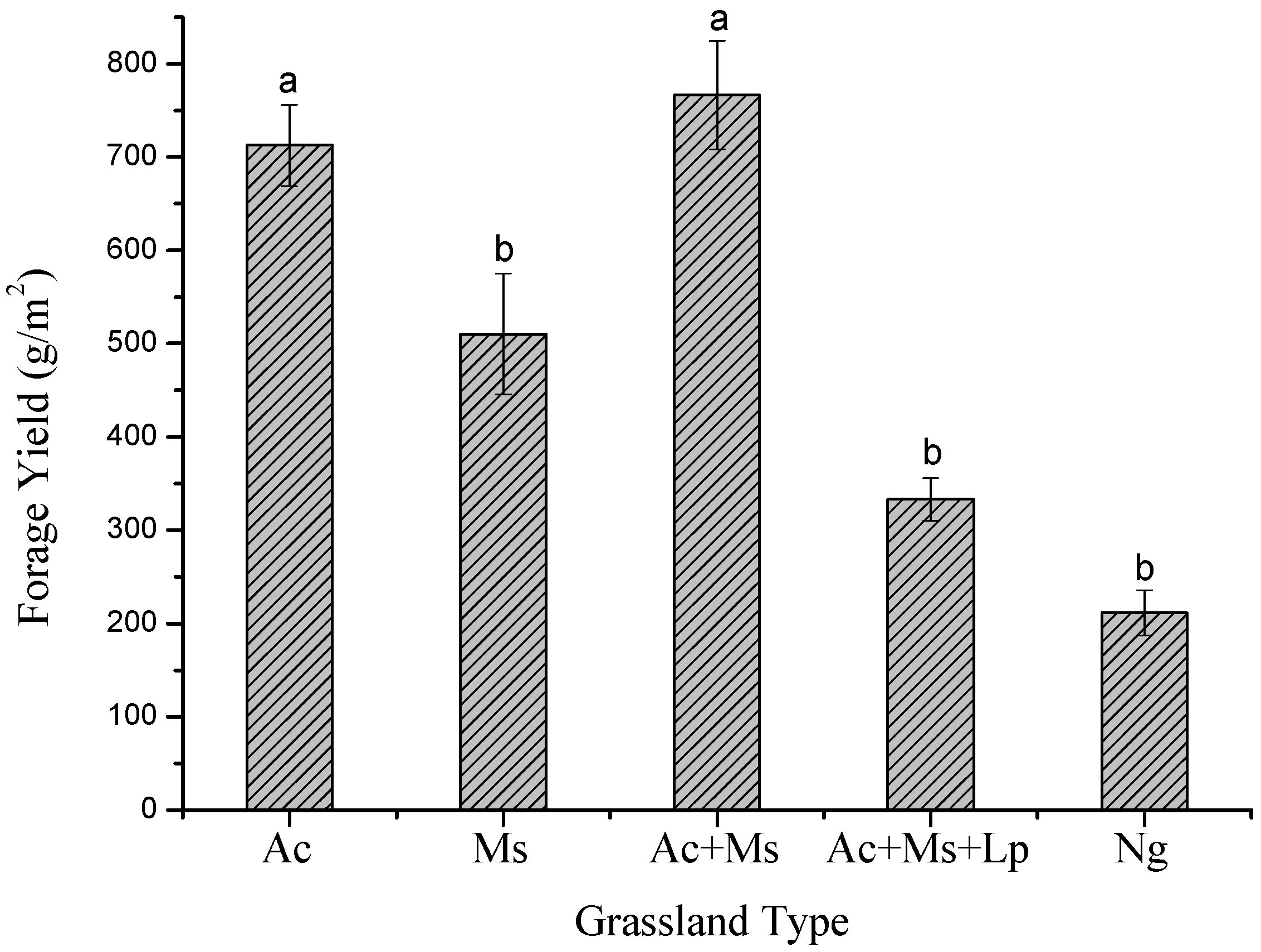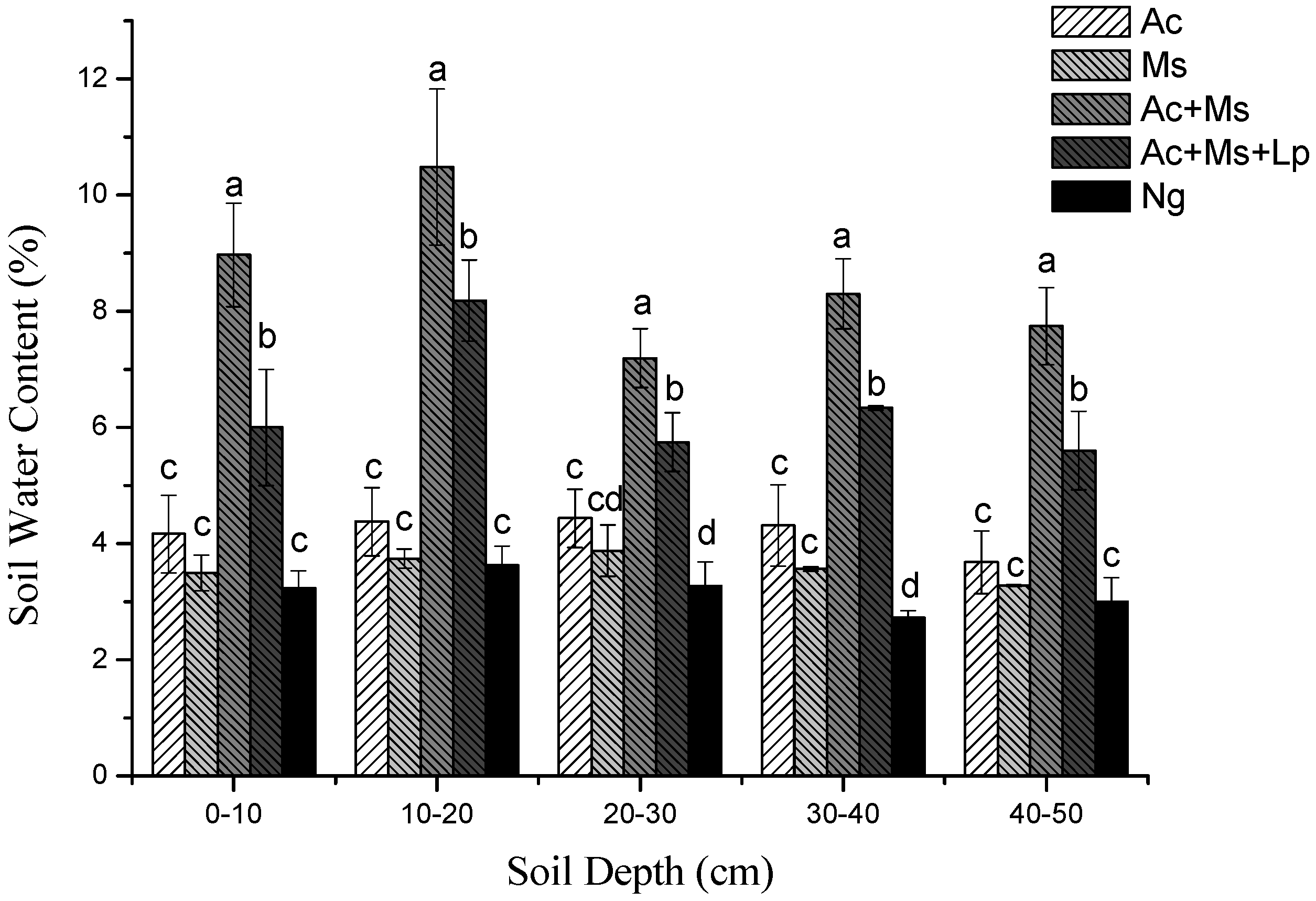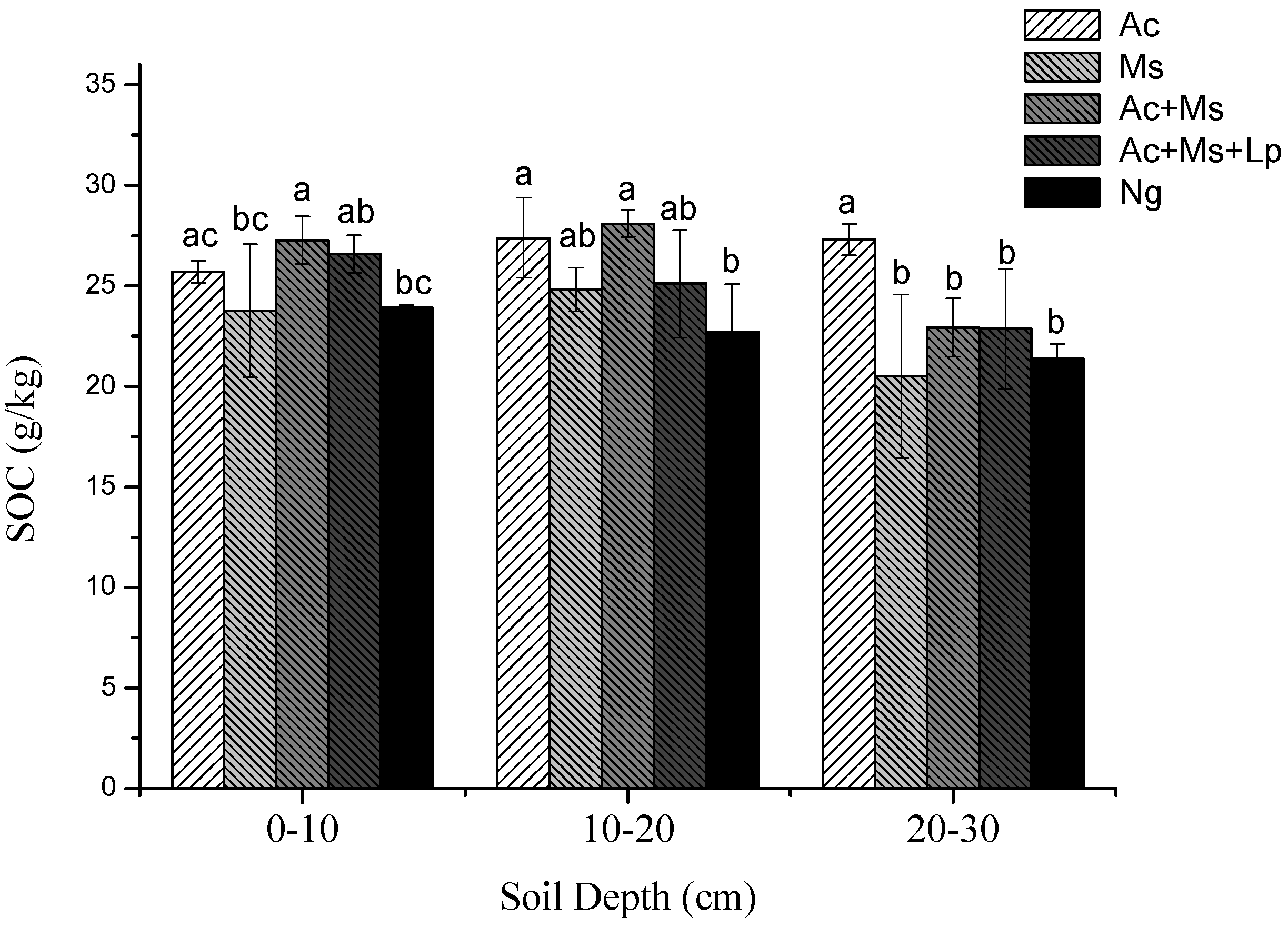A Two-Step Strategy for Developing Cultivated Pastures in China that Offer the Advantages of Ecosystem Services
Abstract
:1. Introduction
2. Materials and Methods
2.1. Site Description
2.2. Sampling and Analysis
2.3. Data Analysis
3. Results
3.1. Forage Yield (AGB)
3.2. Soil Water Content
3.3. Soil Organic Carbon
3.4. Soil Total Nitrogen
4. Discussion
4.1. The Effects of Cultivated Pasture Establishment on Ecosystem Services Provisions Compared to Enclosed Grassland
4.2. Underlying Institutional and Socioeconomic Causes for the Underdevelopment of Cultivated Pasture in China
(1) Economic and institutional factors
(2) Technical factors
(3) Social factors
4.3. A Two-Step Development Strategy
5. Conclusions
Acknowledgments
Author Contributions
Conflicts of Interest
References
- Sun, H.L. Ecosystems of China; Science Press: Beijing, China, 2005. (In Chinese) [Google Scholar]
- Fang, J.Y.; Yang, Y.H.; Ma, W.H.; Mohammat, A.; Shen, H.H. Ecosystem carbon stocks and their changes in China’s grasslands. Sci. China Life Sci. 2010, 53, 757–765. [Google Scholar] [CrossRef] [PubMed]
- Zheng, X.X.; Liu, G.H.; Fu, B.J.; Jin, T.T.; Liu, Z.F. Effects of biodiversity and plant community composition on productivity in semiarid grasslands of Hulunbeir, Inner Mongolia, China. Ann. New York Acad. Sci. 2010, 1195, E52–E64. [Google Scholar] [CrossRef] [PubMed]
- Kang, L.; Han, X.; Zhang, Z.; Sun, O.J. Grassland ecosystems in China: Review of current knowledge and research advancement. Philos. Trans. R. Soc. Lond. B 2007, 362, 997–1008. [Google Scholar] [CrossRef] [PubMed]
- Li, S.G.; Harazono, Y.; Oikawa, T.; Zhao, H.L.; He, Z.Y.; Chang, X.L. Grassland desertification by grazing and the resulting micrometeorological changes in Inner Mongolia. Agric. Forest Meteorol. 2000, 102, 125–137. [Google Scholar]
- Shi, P.; Yan, P.; Yuan, Y.; Nearing, M.A. Wind erosion research in China: past, present and future. Prog. Phys. Geogr. 2004, 28, 366–386. [Google Scholar] [CrossRef]
- Waldron, S.; Brown, C.; Longworth, J. Grassland degradation and livelihoods in China's western pastoral region: A framework for understanding and refining China's recent policy responses. China Agric. Econ. Rev. 2010, 2, 298–320. [Google Scholar] [CrossRef]
- Li, S.; Verburg, P.H.; Lv, S.; Wu, J.; Li, X. Spatial analysis of the driving factors of grassland degradation under conditions of climate change and intensive use in Inner Mongolia, China. Reg. Environ. Change 2012, 12, 461–474. [Google Scholar] [CrossRef]
- Su, Y.Z.; Li, Y.L.; Cui, J.Y.; Zhao, W.Z. Influences of continuous grazing and livestock exclusion on soil properties in a degraded sandy grassland, Inner Mongolia, northern China. Catena 2005, 59, 267–278. [Google Scholar]
- Wang, X.; Han, J.; Dong, Y. Recent grassland policies in China: An overview. Outlook Agric. 2005, 34, 105–110. [Google Scholar] [CrossRef]
- McNaughton, S.J. Grazing as an optimization process: Grass-ungulate relationships in the Serengeti. Am. Nat. 1979, 113, 691–703. [Google Scholar] [CrossRef]
- Xue, R.; Zheng, S.X.; Bai, Y.F. Impacts of grazing intensity and management regimes on aboveground primary productivity and compensatory growth of grassland ecosystems in Inner Mongolia. Biodivers. Sci. 2010, 18, 300–311. (In Chinese) [Google Scholar]
- Zhang, X.S. China must follow the path of the development of artificial grass and grassland farming. Impact Sci. Soc. 2010, 3, 18–21. (In Chinese) [Google Scholar]
- Sollenberger, L.E.; Cherney, D.J.R. The Science of Grassland Agriculture; The Iowa State University Press: Ames, IA, USA, 2006. [Google Scholar]
- Niu, S.L.; Jiang, G.M. Function of artificial grassland in restoration of degraded natural grassland and its research advance. J. Appl. Ecol. 2004, 15, 1662–1666. (In Chinese) [Google Scholar]
- Hu, Z.Z. The importance of artificial grassland in the development of prataculture and the control of environment in China of 21 century. Grassl. Turf 2000, 27, 12–15. (In Chinese) [Google Scholar]
- The Ministry of Agriculture, P.R.C. Grass Industry Sustainable Development Strategy in China; China Agriculture Press: Beijing, China, 2006. (In Chinese)
- Millennium Ecosystem Assessment. Ecosystems and Human Well-Being: A Framework for Assessment; Island Press: Washington, DC, USA, 2005. [Google Scholar]
- Finn, J.A.; Kirwan, L.; Connolly, J.; Sebastià, M.T.; Helgadottir, A.; Baadshaug, O.H.; Čop, J. Ecosystem function enhanced by combining four functional types of plant species in intensively managed grassland mixtures: A 3-year continental-scale field experiment. J. Appl. Ecol. 2013, 50, 365–375. [Google Scholar] [CrossRef]
- Serrao, E.A.S.; Falesi, I.C.; Veiga, J.D.; Teixeira, N.J.F. Productivity of Cultivated Pastures on Low Fertility Soils in the Amazon of Brazil. In Pasture Production in acid Soils of the Tropics; CIAT: Cali, Colombie, 1979; pp. 195–225. [Google Scholar]
- Xu, B.C.; Shan, L. Aboveground productivity and soil water characteristics of cultivated Old World bluestem grassland in semi-arid loess hilly-gully areas on the Loess Plateau. Pratacultural Sci. 2004, 21, 6–10. (In Chinese) [Google Scholar]
- Qi, Y.L.; Liu, X.Q.; Li, Y. The ecological and economic benefits analysis on cultivated pastures established on abandoned croplands in Qaidam Basin. Prataculture Anim. Husb. 2008, 3, 10–13. (In Chinese) [Google Scholar]
- Jiao, J.Y.; Wang, W.Z. The benefits of runoff and sediment reduction & effective cover rate for soil and water conservation of artificial grassland on Loess Plateau. Acta Agrestia Sin. 2001, 9, 176–182. (In Chinese) [Google Scholar]
- Soussana, J.F.; Allard, V.; Pilegaard, K.; Ambus, P.; Amman, C.; Campbell, C.; Flechard, C. Full accounting of the greenhouse gas (CO2, N2O, CH4) budget of nine European grassland sites. Agric. Ecosyst. Environ. 2007, 121, 121–134. [Google Scholar] [CrossRef]
- Teixeira, R.F.M.; Domingos, T.; Costa, A.P.S.V.; Oliveira, R.; Farropas, L.; Calouro, F.; Carneiro, J.P.B.G. Soil organic matter dynamics in Portuguese natural and sown rainfed grasslands. Ecol. Model. 2011, 222, 993–1001. [Google Scholar] [CrossRef]
- Chevallier, T.; Voltz, M.; Blanchart, E.; Chotte, J.L.; Eschenbrenner, V.; Mahieu, M.; Albrecht, A. Spatial and temporal changes of soil C after establishment of a pasture on a long-term cultivated vertisol (Martinique). Geoderma 2000, 94, 43–58. [Google Scholar] [CrossRef]
- Wang, S.; Wilkes, A.; Zhang, Z.; Chang, X.; Lang, R.; Wang, Y.; Niu, H. Management and land use change effects on soil carbon in northern China’s grasslands: a synthesis. Agric. Ecosyst. Environ. 2011, 142, 329–340. [Google Scholar] [CrossRef]
- Suter, M.; Connolly, J.; Finn, J.A.; Helgadóttir, Á.; Kirwan, L.; Loges, R.; Hopkins, A. Grass-legume mixtures enhance yield of total nitrogen and uptake from symbiotic N2 fixation: Evidence from a three-year multisite experiment. In the Role of Grasslands in a Green Future: Threats and Perspectives in Less Favoured Areas; Proceedings of the 17th Symposium of the European Grassland Federation, Akureyri, Iceland, 23–26 June 2013; Agricultural University of Iceland: Hvanneyri, Iceland, 2013; pp. 76–78. [Google Scholar]
- Wu, G.L.; Liu, Z.H.; Zhang, L.; Hu, T.M.; Chen, J.M. Effects of artificial grassland establishment on soil nutrients and carbon properties in a black-soil-type degraded grassland. Plant Soil 2010, 333, 469–479. [Google Scholar] [CrossRef]
- Török, P.; Deák, B.; Vida, E.; Valkó, O.; Lengyel, S.; Tóthmérész, B. Restoring grassland biodiversity: Sowing low-diversity seed mixtures can lead to rapid favourable changes. Biol. Conserv. 2010, 143, 806–812. [Google Scholar] [CrossRef]
- Jones, C.C.; Dreyer, G.D.; Barrett, N. Evaluating the Success of Seed Sowing in a New England Grassland Restoration. Nat. Areas J. 2013, 33, 214–221. [Google Scholar] [CrossRef]
- Gómez-Rey, M.X.; Garcês, A.; Madeira, M. Soil organic C accumulation and N availability under improved pastures established in Mediterranean oak woodlands. Soil Use Manag. 2012, 28, 497–507. [Google Scholar]
- Gómez-Rey, M.X.; Madeira, M.; Gonzalez-Prieto, S.J.; Coutinho, J. Soil C and N dynamics in a Mediterranean oak woodland with shrub encroachment. Plant Soil 2013, 371, 339–354. [Google Scholar] [CrossRef]
- Price Department, the National Development and Reform Commission, People’s Republic of China. Data Compilation of Costs and Benefits of Agricultural Products in China; China Statistics Press: Beijing, China, 2014. (In Chinese)
- The Department of Agriculture and Animal Husbandry, Inner Mongolia Autonomous Region, People’s Republic of China. The Twelfth Five Year Plan for Cultivated Pasture Establishment of Inner Mongolia Autonomous Region; The Department of Agriculture and Animal Husbandry, Inner Mongolia Autonomous Region: Hohhot, China, 2011. (In Chinese)
- Sheley, R.L.; Half, M.L. Enhancing native forb establishment and persistence using a rich seed mixture. Restor. Ecol. 2006, 14, 627–635. [Google Scholar] [CrossRef]
- Atanu, S.; Love, H.A.; Schwart, R. Adoption of emerging technologies under output uncertainty. Am. J. Agric. Econ. 1994, 76, 836–846. [Google Scholar]
- Khanna, M. Sequential adoption of site-specific technologies and its implications for nitrogen productivity: A double selectivity model. Am. J. Agric. Econ. 2001, 83, 35–51. [Google Scholar] [CrossRef]
- International Union for Conservation of Nature (IUCN). No Time to Lose: Make Full Use of Nature-Based Solutions in the Post-2012 Climate Change Regime; IUCN: Gland, Switzerland, 2009. [Google Scholar]
- European Commission. Towards an EU Research And Innovation Policy Agenda for Nature-Based Solutions & Re-Naturing Cities; Final Report of the Horizon 2020 expert group on nature-based solutions and re-naturing cities; European Commission: Brussels, Belgium, 2015. [Google Scholar]
- Eggermont, H.; Balian, E.; Azevedo, J.M.N.; Beumer, V.; Brodin, T.; Claudet, J.; Reuter, K. Nature-based Solutions: New Influence for Environmental Management and Research in Europe. GAIA-Ecol. Perspect. Sci. Soc. 2015, 24, 243–248. [Google Scholar] [CrossRef]
- Teixeira, R.F.; Proença, V.; Crespo, D.; Valada, T.; Domingos, T. A conceptual framework for the analysis of engineered biodiverse pastures. Ecol. Eng. 2015, 77, 85–97. [Google Scholar] [CrossRef]




| Treatments | Seeding Schemes | Seeding Methods |
|---|---|---|
| Ac | Monoculture of A. cristatum | 22.5 kg/hm2 of Ac seeds were sown |
| Ms | Monoculture of M. sativa | 22.5 kg/hm2 of Ms seeds were sown |
| Ac + Ms | Mixed culture of A. cristatum and M. sativa | 22.5 kg/hm2 of seeds were sown, with Ac and Ms accounting for 50% each |
| Ac + Ms + Lp | Mixed culture of A. cristatum, M. sativa, and L. perenne | 22.5 kg/hm2 of seeds were sown, with Ac, Ms, and Lp accounting for 1/3 each |
| Items | Sub-Items | Yuan/mu | Notes |
|---|---|---|---|
| Cost | Plowing | 25 | |
| Harrowing | 25 | ||
| Sowing | 15 | ||
| Seed purchasing | 56 | 28 yuan/kg × 2 kg/mu | |
| Fertilizers | 22 | 4.4 yuan/kg × 5 kg/mu | |
| Tending | 18 | ||
| Total cost | 161 | ||
| Benefit | Hay sales | 360 | 1800 yuan/ton × 0.2 ton/mu |
| Net benefit | 199 | ||
© 2016 by the authors; licensee MDPI, Basel, Switzerland. This article is an open access article distributed under the terms and conditions of the Creative Commons Attribution (CC-BY) license (http://creativecommons.org/licenses/by/4.0/).
Share and Cite
Chen, H.; He, L.; Tang, H.; Zhao, M.; Shao, L. A Two-Step Strategy for Developing Cultivated Pastures in China that Offer the Advantages of Ecosystem Services. Sustainability 2016, 8, 392. https://doi.org/10.3390/su8040392
Chen H, He L, Tang H, Zhao M, Shao L. A Two-Step Strategy for Developing Cultivated Pastures in China that Offer the Advantages of Ecosystem Services. Sustainability. 2016; 8(4):392. https://doi.org/10.3390/su8040392
Chicago/Turabian StyleChen, Haibin, Li He, Haiping Tang, Minjuan Zhao, and Liqun Shao. 2016. "A Two-Step Strategy for Developing Cultivated Pastures in China that Offer the Advantages of Ecosystem Services" Sustainability 8, no. 4: 392. https://doi.org/10.3390/su8040392






